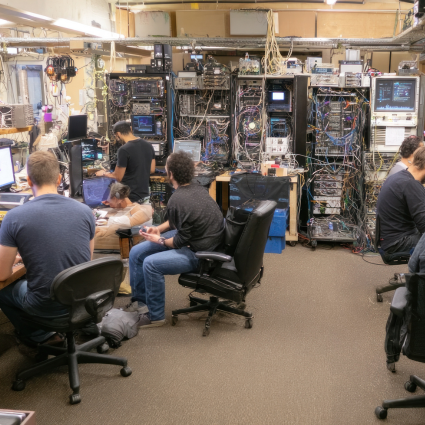What Caused the Chip Shortage?
We can attribute the chip shortage to 4 major reasons:
- Stagnant historical growth caused hardware refreshes to align too closely across most companies
- COVID-19
- TSMC
- Unprecedented demand
Stagnant Growth
The short answer to this is, it was the perfect storm, but let’s dig a little deeper. Typically, enterprise companies refresh hardware somewhere in the 3-5 year range. Some may refresh sooner than 3 or hang on longer than 5, it really depends on each company. In 2017 and 2018 there was a big refresh boom, mainly because from 2011-2017 the market was very stagnant. Intel had a hold on most of the market because AMD had many failures in a row, resulting in most consumer and enterprise companies mostly using Intel-based products. There were times when Intel had nearly 90% of the market share across the board. This led to improvements year-over-year to be very little.
Then 2017 hit, AMD released their Zen architecture which hit the enterprise market as code name EPYC which now competed with Intel in core count and performance and undercut pricing. AMD began to compete heavily with Intel which led to many enterprise customers refreshing during these years. And since, the battle has been close allowing us to have a competitive market of innovation.
COVID-19
So now, we are five years removed from the big refresh and since 2020, companies have been executing their regular refreshes. Many companies had planned their refreshes ranging from 2020-2022. But that is when COVID-19 hit. This caused production to halt completely, supply chains broken down and products ran dry. Many companies had put their refreshes on hold due to potential company outlooks. Then when things began to get better, companies began to revisit refreshing hardware.
TSMC
Tawaiinese Semiconductor Manufacturing Company INC or TSMC is responsible for a large portion of chips manufactured. They make chips for AMD, Apple and a vast majority of appliances, cars, etc. So they were already constrained due to factory shutdowns and supply shortages, and since they make the most chips out there for consumer and enterprise equipment, we have a run of supply on a single company, which is also a single point of failure.
Unprecedented Demand
Remember how companies by and large did not refresh hardware in 2020 due to COVID-19? They were now doing it in 2021, alongside companies who planned to refresh in 2021. There were talks of long lasting chip shortages, so companies who planned their hardware refresh in 2022, moved it up to 2021. Now we have three years worth of companies trying to refresh hardware at the exact same time.
On the consumer side of things, we saw unprecedented growth in compute performance for graphics cards. AMD finally made a top tier card to compete with NVidia, both companies were very competitive across the price brackets. Something we haven’t seen for six years. People were sitting on graphics cards from 2018 waiting to upgrade, or even older. Now both companies had compelling offers. Everyone flooded the market with older graphics cards in anticipation of buying the newest ones. Then, there weren’t any and nearly all used graphics cards already went through the market. This caused older cards like the GTX 1060 which sold for $280 in 2016 brand new, to sell used for over $300.
The TL:DR
Lack of innovations in the computing world led to pushing refreshes and consumer purchases to a tight window. COVID-19 caused supply chain and production delays. It was the perfect storm of the largest demand in history during the lowest supply capabilities.
Networking Equipment Shortages?
When looking at the largest networking vendor in the world, they published in their annual report that shortages are drastically impacting their lead times. Their fear is if they spend too much on inflated prices of components and their projections fall below expectations, it would have a huge negative impact on their bottom line. So they can’t just go out there and buy up everything to increase production. The fear is when speculation that the market will start to see correction, it will drastically kill demand.
We’ve already seen that, now that consumer graphics cards can be purchased in stores and online regularly, we have seen a sharp decline in inflated prices in a matter of weeks. While enterprise products would probably not see a correction that fast, it would significantly impact networking vendors this size.
Why Long Lead Times on Networking Equipment?
As mentioned above, networking vendors and enterprise hardware companies are running a tight ship. While they are making significant profits due to markup, the market is very volatile. Large networking vendors will continue to keep a hold of their COGS and inventory to accurately predict future earnings and proper forecasting. So until one company makes a commitment and says, “Hey look, we have tons of inventory at a good price”, the artificial demand will still exist.
But there is also another reason, the supply chain is still behind. While there are enough processors to go into switches and APs being sent to networking vendors, integrating the chips into boards and shipping is still very much behind. This is the same reason why I can buy a consumer or enterprise AMD or Intel Chip at MSRP today, but cars are still short. Getting chips into the cars is the bigger issue (and the run on cars is still insane at the moment).
How Long are the Lead Times on Networking Equipment?
Hard to say, I read a Reddit thread two months ago citing over 400 days. Many people are deferring to other networking vendors who may not have the full feature set that they need but if they are at the 4-5 year mark, the equipment needs to be updated. Our customers have communicated that some of the smaller vendors are inside of 6 months, but most of the larger vendors are 9-12 months or longer.
What About NetBeez?
Well, we are fortunate in that we have really pushed for virtual applications of NetBeez for the past few years. Our Remote Worker Agent is very popular and the supply run on business laptops is not as bad as it was a year ago. But luckily laptops from 2018 that are still running can be upgraded with memory/SSDs and still be viable for years to come.
One thing we have noticed is, in the past 12 months, we have seen significantly more refreshes than any previous 12 month period in our company’s history. We have also used this as an opportunity to visit some upgrades on our side of agent development as well. So of course we have seen the shortages and cost increases, we are lucky that we are not as dependent on hardware as many companies are.
What is the Solution, is There Opportunity?
Only time will tell but time is the answer. We saw that Intel is opening up a Chip Fab in Ohio and while that may be a long way off, it may prevent these shortages in the future. Shortages do happen every few years due to increased demand, especially when we see a big increase in performance, power efficiency and/or feature set.
The other solution is to be agile. The reality is, especially in the networking space, there are a few big vendors, one is definitely the largest by far, but there are many vendors for networking equipment to consider, especially if you’re not a giant Fortune 100 company!
Speaking of other networking vendors, this chip shortage gives lesser known vendors and smaller vendors the chance to shine. If they have inventory, they have a chance to get their products in front of more people. As long as the products AND service are good, this could actually lead to a more equal distribution of vendors in this space!
Conclusion
We don’t know when the shortage will end. What we do know is that certain segments are doing better than others. My hope is that we learn from our mistakes and how we go here. We had too much reliance on a single chip manufacturer, a big reliance on a single networking vendor and this has led to many problems in just our industry alone!





